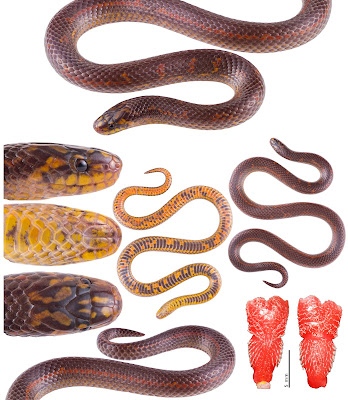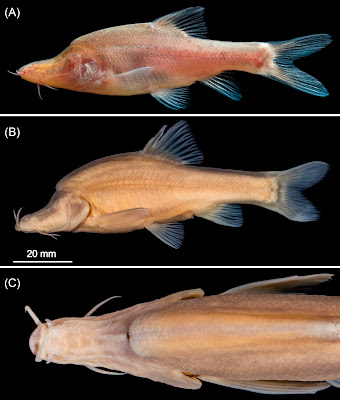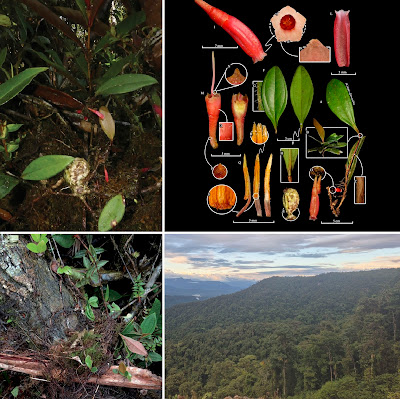 |
| Raorchestes jakoid Warjri, Purkayastha, Lalremsanga & Das, 2025 |
Abstract
The genus Raorchestes Biju et al., 2010 represents one of the most diverse lineages within the family Rhacophoridae, with its members characterized by small size, absence of vomerine teeth, direct development, and distinctive digital discs with circum-marginal grooves. Despite its location in the Indo-Burma biodiversity hotspot, the amphibian diversity of Meghalaya remains underexplored. In this study, we describe two new species, Raorchestes jakoid sp. nov. and Raorchestes jadoh sp. nov., from the Khasi Hills of Meghalaya, based on an integrative approach combining morphological, bioacoustic, and molecular data (16S rRNA). Additionally, we provide new records and supplementary descriptions for three species: R. kempiae, R. garo, and R. asakgrensis, thereby improving our understanding of their intraspecific variation and distribution. Phylogenetic analyses confirm the placement of the new species within the Raorchestes parvulus species complex. The new species are distinguished by a suite of morphological traits, unique call structures, and genetic divergence from congeners. Notably, both new species were discovered in secondary habitats near human settlements, suggesting ecological tolerance yet raising concerns about their long-term survival amid rapid habitat loss. The elevational distribution of the species studied ranges from 235 m to 1,655 m, with a concentration between 1,000–1,600 m, highlighting patterns of elevational partitioning and habitat specialization. Our findings add to the growing evidence of high cryptic diversity in the region and underscore the urgent need for targeted herpetofaunal surveys and conservation actions in Northeast India.
Keywords: 16SrRNA, acoustic, biodiversity, conservation, endemism, Indo-Burma biodiversity hotspot, morphology, parvulus complex, systematics, taxonomy
Etymology: The specific epithet ‘jadoh’ is derived from the name of a traditional rice and meat dish that is integral to the cuisine and cultural identity of the Khasi people of Meghalaya, northeastern India. The name is used here as a noun in apposition. This naming celebrates Khasi heritage and underscores the connection between local biodiversity and indigenous cultural practices.
Diagnostic characters: While the developmental mode of the newly described species, Raorchestes jadoh sp. nov., remains uncertain, its placement within the genus Raorchestes is supported by the following combination of characteristics: small body size, vomerine teeth absent, male possess transparent gular pouch which is visible when calling, and tips of all fingers and toes expanded into discs with circum-marginal grooves. The new species is distinguished from relevant congeners by phylogenetic position, by call analysis based on the parameters dominant frequency, call duration, inter-call interval, call repetition rate, number of note, note duration, and inter-note interval, and by the combination of the following morphological characters: very small body size with SVL of 13.68−14.01 mm; head wider than long; tympanum indistinct, supratympanic fold distinct; tongue pyriform and notched posteriorly, webbing between fingers absent; rudimentary webbing between toes present; relative finger lengths: I < II < IV < III, relative toe lengths: I < II < III < V < IV; inner palmar tubercle absent and outer palmar tubercle present with round shape; tibiotarsal articulation reaching posterior border of an eye when hindlimb is stretched alongside of body; nuptial pad present; inner metatarsal tubercle round (IMT/Toe4L 0.08 mm long), outer metatarsal tubercle absent; interorbital distance larger than eye horizontal diameter; upper part with small warts and six fairly distinct warts on the body towards the posterior of the eyes.
Raorchestes jakoid sp. nov.
Etymology: The specific epithet ‘jakoid’ is derived from the Khasi word for “frog” (jakoid), used by the indigenous Khasi people of Meghalaya, northeastern India. The name is treated as a noun in apposition. This nomenclature honours the rich linguistic and cultural heritage of the Khasi community, and emphasizes the importance of local traditional knowledge in the discovery, and conservation of biodiversity in the Khasi Hills.
Diagnostic characters: While the developmental mode of the newly described species, Raorchestes jakoid sp. nov., remains uncertain, its placement within the genus Raorchestes is supported by the following combination of characteristics: small body size, vomerine teeth absent, male possesses transparent gular pouch which is visible when calling, and tips of all fingers & toes expanded into discs with circum-marginal grooves. The new species is distinguished from relevant congeners by phylogenetic position, by call analysis based on parameters like dominant frequency, call duration, inter-call interval, call repetition rate, number of note, note duration, and inter-note interval, and by the combination of the following morphological characteristics: small body size with SVL of 18.47−21.6 mm; head wider than long; tympanum indistinct, supratympanic fold distinct; tongue pyriform, and notched posteriorly; webbing between fingers absent; rudimentary webbing between toes present; relative finger lengths: I < II < IV < III, relative toe lengths: I < II < III < V < IV; inner palmar tubercle absent and outer palmar tubercle present with round shape; tibiotarsal articulation reaching posterior border of an eye when hindlimb is stretched alongside of body; nuptial pad distinctly whitish in colour; inner metatarsal tubercle oval (IMT/Toe4L 0.07 long), outer metatarsal tubercle absent; body surface slightly rough and has”)(“ shaped marking; interorbital distance larger than eye horizontal diameter; upper parts with very small warts.
Holiness Warjri, Jayaditya Purkayastha, Hmar Tlawmte Lalremsanga and Madhurima Das. 2025. Two New Species of Bush Frogs (Anura: Rhacophoridae: Raorchestes) from Meghalaya, northeastern India. Journal of Threatened Taxa. 17(7); 27171-27194. DOI: doi.org/10.11609/jott.9461.17.7.27171-27194































